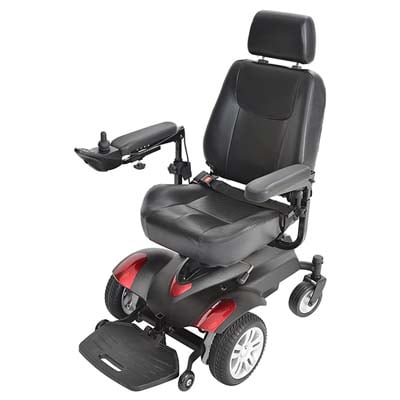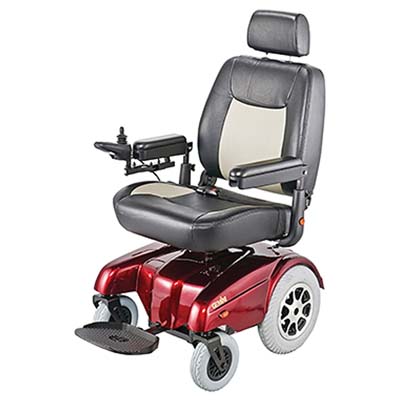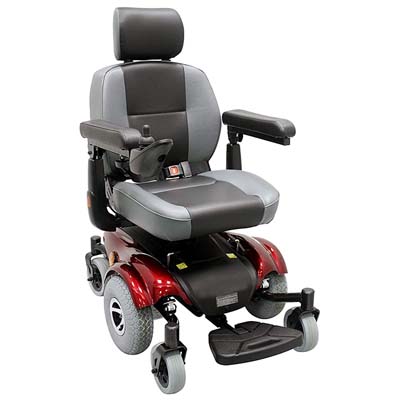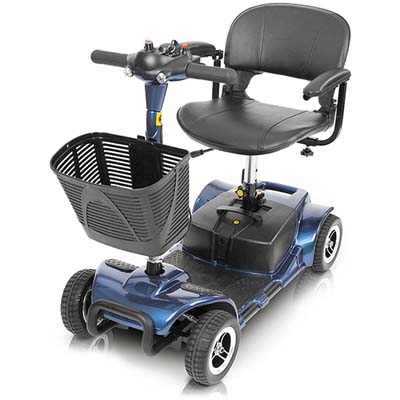Are you in the market for a new power chair? Are you struggling to make sense of the drive configuration options available? If you answered yes to either of those questions, then this article is for you.
The drive configuration of the chair you’re considering matters more than you may think, so selecting the “right” one for you really matters. In this piece, we’ll outline the pros and cons of each so you can make an informed decision. The better aligned the drive configuration is with how you plan on using your chair, the happier you’ll be with it overall.
With that in mind, let’s take a closer look.
Available Power Wheelchair Drive Configurations
In the world of power chairs, there are four options available:
This last option is only available in a few niche products that tend to be at the very top of the price spectrum, but we’ll still spend a few minutes talking about its pros and cons for those who can afford chairs like that. So, taking these in order, we’ve got:
Front-Wheel Drive
Front-wheel drive chairs were popularized in the late 1960s by a company called Permobil. Pulling is easier than pushing, so front-wheel drive chairs tend to be more powerful but have lower top speeds than chairs that feature different drive configurations.

From a day-to-day use perspective, the primary benefit of a front-wheel drive chair is the ability to power over obstacles that are in your way. If you plan to use your chair mostly in urban environments, for example, a good front-wheel drive chair will help you muscle your way over curbs with relative ease.
Also, since pulling is easier than pushing, front-wheel drive chairs perform better on softer surfaces. Depending on how you plan to use the chair, that may be vitally important or not important at all.
In addition to that, front-wheel drive chairs offer a relatively smooth, stable ride. Since the chair’s pivot point is at the front, you’ll need to practice turning and approach turns from the “inside track” to give the back-end space to swing around.
Also, be aware that the back end is more likely to fishtail with a front-wheel drive configuration in hazardous conditions. This is especially true at higher speeds, which is the main reason that the speeds are kept lower on most front-wheel drive models.
Finally, although front-wheel drive chairs are quite adept at handling inclines, they can become unstable on steeply sloping downhills, which could cause the chair to pitch forward.
Front-Wheel Drive Pros and Cons at a glance:
PROS
CONS
Rear-Wheel Drive
Rear-wheel-drive power chairs were first introduced in 1956 by Everest & Jennings and have been the industry standard since their introduction. It’s easy to see why because the rear-wheel drive chair has a lot going for it.

Although it’s more difficult to push than pull, rear-wheel drive chairs offer a great deal of stability and are masterful at handling slopes. You don’t need to worry about pitching forward as you do on steep downhills if you’re driving a front-wheel drive chair.
On the other hand, the rear-wheel-drive chair doesn’t handle obstacles as well as a front-wheel drive, and they’re not nearly as adept at handling soft surfaces, either.
If you give your rear-wheel drive chair a sudden burst of power, you do run the risk of tipping (popping a wheelie!), which can be unsettling the first time that it happens. On the other hand, intentionally doing so can help you get over curbs and other obstacles that your chair would likely get hung up on otherwise.
Rear-Wheel Drive Pros and Cons at a glance:
PROS
CONS
Center-Wheel Drive
Pride Mobility introduced the first Mid-Wheel drive chair in 1996, and most other power chair manufacturers quickly followed suit.

Hands down, the biggest advantage of a mid-wheel drive chair is its tight turning radius. Since the pivot point of the chair is “center post,” these chairs can turn on a dime, which makes them ideally suited for indoor use, especially if you live in a smaller home or apartment. These chairs also have anti-tippers both front and back, which maximizes stability.
Unfortunately, center-wheel drive chairs suffer the same basic limitation that rear-wheel drive chairs suffer from; they’re just not as good at powering their way over obstacles in front of you like curbs.
The tiny casters on the front tend to get hung up on them. Unlike a rear-wheel drive model, you can’t just pop a wheelie to get over the curb anyway. It means that you’ll likely have to drive out of your way to find a place where you can access the sidewalk without having to contend with the curb.
Also, mid-wheel drive chairs tend to be slow as they can become increasingly difficult to handle at higher speeds.
Mid-Wheel Drive Pros and Cons at a glance:
PROS
CONS
Four-Wheel Drive
As we mentioned at the start, four-wheel drive chairs aren’t very numerous in number. They exist, but you’ll pay a premium for them.

The big advantage that a four-wheel drive chair has to offer is that it can go just about anywhere. Most of these chairs have a relatively high clearance, so they’re better suited to outdoor terrains, and they can power over most obstacles in your way with relative ease. These types of chairs are also often offered with impressive top speeds. So if you want a chair with some zip, then 4WD chairs will usually deliver.
Unfortunately, four-wheel drive chairs tend to turn relatively poorly (poor turning radius), which means that they tend to take a lot of space to use. That, in turn, makes them relatively poor fits for indoor use, and even outdoors, you may find yourself having to execute frequent three-point turns to get yourself turned around.
These types of chairs also offer a relatively rough ride. They’re fine for shorter trips. But if you spend the better part of a day with one, you’ll probably feel it by the time the day’s over.
Four-Wheel Drive Pros and Cons at a glance:
PROS
CONS
Final Thoughts on Wheelchair Drive Configurations
So, which drive configuration is right for you? Ultimately, that’s what matters. To make that decision, you should consider carefully where and how you plan to use the chair. Quite often, when you answer the “where” and the “how,” then the answer to the optimal drive configuration question becomes obvious.